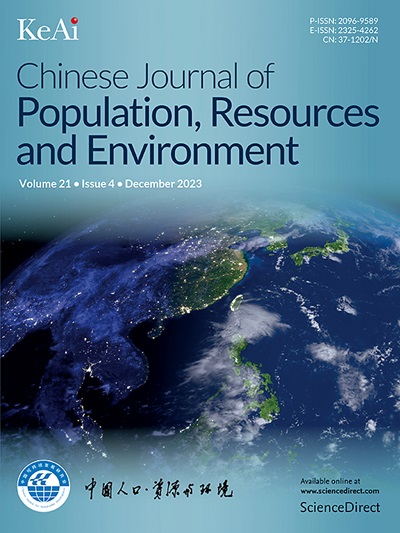Technological anxiety: Analysis of the impact of industrial intelligence on employment in China
IF 4.8
4区 环境科学与生态学
Q2 ENVIRONMENTAL STUDIES
Chinese Journal of Population Resources and Environment
Pub Date : 2024-09-01
DOI:10.1016/j.cjpre.2024.09.013
引用次数: 0
Abstract
Employment is the greatest livelihood. Whether the impact of industrial robotics technology materialized in machines on employment in the digital age is an “icing on the cake” or “adding fuel to the fire” needs further study. This study aims to analyze the impact of the installation and application of industrial robots on labor demand in the context of the Chinese economy. First, from the theoretical logic and the economic development law, this study gives the prior judgment and research hypothesis that industrial intelligence will increase jobs. Then, based on the panel data of 269 cities in China from 2006 to 2021, we use the two-way fixed effect model, dynamic threshold model, and two-stage intermediary effect model. The objective is to investigate the impact of industrial intelligence on enterprise labor demand and its path mechanism. Results show that the overall effect of industrial intelligence on the labor force with the installation density index of industrial robots as the proxy variable is the “creation effect”. In other words, advanced digital technology has created additional jobs, and the overall supply of employment in the labor market has increased. The conclusion is still valid after the endogeneity identification and robustness test. In addition, the positive effect has a nonlinear effect on the network scale. When the installation density of industrial robots exceeds a particular threshold value, the division of labor continues to deepen under the combined action of the production efficiency and compensation effects, which will cause enterprises to increase labor demand further. Further research showed that industrial intelligence can increase employment by promoting synergistic agglomeration and improving labor price distortions. This study concludes that in the digital China era, the introduction and installation of industrial robots by enterprises can affect the optimal allocation of the labor market. This phenomenon has essential experience and reference significance for guiding industrial digitalization and intelligent transformation and promoting the high-quality development of people’s livelihood.
技术焦虑工业智能化对中国就业的影响分析
就业是最大的民生。数字时代,工业机器人技术在机器上的具体化对就业的影响是 "锦上添花 "还是 "火上浇油",还需要进一步研究。本研究旨在以中国经济为背景,分析工业机器人的安装和应用对劳动力需求的影响。首先,从理论逻辑和经济发展规律出发,本研究给出了工业智能化将增加就业岗位的先验判断和研究假设。然后,基于 2006 年至 2021 年中国 269 个城市的面板数据,采用双向固定效应模型、动态门槛模型和两阶段中介效应模型。目的是研究产业智能化对企业用工需求的影响及其路径机制。结果表明,以工业机器人安装密度指数为替代变量,工业智能化对劳动力的总体影响是 "创造效应"。也就是说,先进的数字化技术创造了更多的就业岗位,劳动力市场的整体就业供给增加了。经过内生性识别和稳健性检验后,该结论依然有效。此外,正效应对网络规模有非线性影响。当工业机器人的安装密度超过某一临界值时,在生产效率效应和补偿效应的共同作用下,分工继续深化,会使企业进一步增加劳动力需求。进一步的研究表明,工业智能化可以通过促进协同集聚和改善劳动力价格扭曲来增加就业。本研究认为,在数字中国时代,企业引进和安装工业机器人会影响劳动力市场的优化配置。这一现象对于引导工业数字化、智能化转型,促进民生高质量发展具有不可或缺的经验和借鉴意义。
本文章由计算机程序翻译,如有差异,请以英文原文为准。
求助全文
约1分钟内获得全文
求助全文
来源期刊

Chinese Journal of Population Resources and Environment
ENVIRONMENTAL STUDIES-
CiteScore
4.30
自引率
1.10%
发文量
791
审稿时长
79 days
期刊介绍:
The Chinese Journal of Population, Resources and Environment (CJPRE) is a peer-reviewed international academic journal that publishes original research in the fields of economic, population, resource, and environment studies as they relate to sustainable development. The journal aims to address and evaluate theoretical frameworks, capability building initiatives, strategic goals, ethical values, empirical research, methodologies, and techniques in the field. CJPRE began publication in 1992 and is sponsored by the Chinese Society for Sustainable Development (CSSD), the Research Center for Sustainable Development of Shandong Province, the Administrative Center for China's Agenda 21 (ACCA21), and Shandong Normal University. The Chinese title of the journal was inscribed by the former Chinese leader, Mr. Deng Xiaoping. Initially focused on China's advances in sustainable development, CJPRE now also highlights global developments from both developed and developing countries.
 求助内容:
求助内容: 应助结果提醒方式:
应助结果提醒方式:


